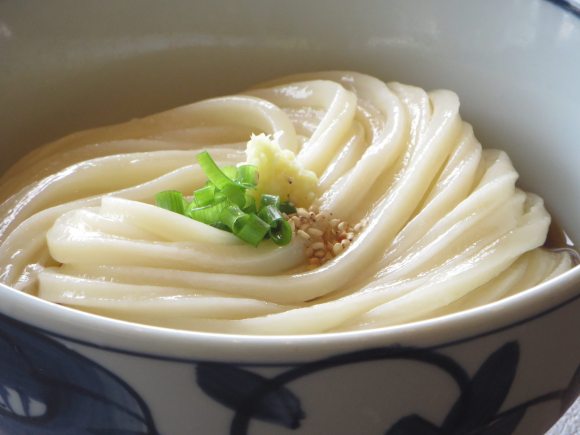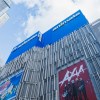
Actually never mind that, tasting any wattage isn’t really recommended, despite my own preference for licking 9V batteries. Nevertheless, a power source fueled largely by Japan’s girthy noodles called udon is now currently in operation in Takamatsu City, Kagawa Prefecture.
Although generating power from bio-organic sources is nothing new, it seems this plant-based plant has found a way to be sustainable using a peculiar quirk of Kagawa’s udon rich culture.
■ Biogas
For those not familiar with biogas, it’s the process of fermenting organic waste such as discarded food or manure so that it releases various gases including methane which can be used to generate electricity. According to Back to the Future II, it will be perfected by next year and will be enough to power our flying cars. Also, as Mad Max Beyond Thunderdome has shown us, this technique will last us until long after the nuclear apocalypse has occurred.
Here’s a handy diagram on how it works with the help of Yellow Dragonman (actually a woman) who is part of UDON (Ultra Defensers of Nature).
Widespread use of biogas around the world has been relatively slow to develop, but it continues to be steadily on the rise. As mechanical engineering firm Chiyoda Seisakusho in Kagawa has learned, it just needs the right conditions to flourish.
■ Udon Prefecture
Kagawa Prefecture is the nation’s leader in udon production and quality, earning it the nickname “Udon Prefecture.” Udon is a type of thick floury noodle loved by Japanese diners everywhere. There’s also the delectable Sanuki udon of Kagawa with its thicker and more rigid feel. Inside the prefecture, competition to serve the best Sanuki udon is strong, and restaurants have to offer up the freshest and fastest bowls to please discerning customers.
As a result, despite their best efforts at conservation this struggle to keep their noodles the best creates a fair degree of waste. A popular restaurant in Takamatsu City, Sanuki Mengyo reported an annual loss of 5% of their noodle stock (150 tons). It seems that wasting noodles has long been a financial burden of the udon restaurant business, one which Sanuki Mengyo calculates to 4.5 million yen (US$44,000) annually.
■ Using 100% of your udon
It could be said that udon is the life-blood of Kagawa with many people making their livings off of the foodstuff. Farmers, factory workers, restaurant staff, and more all rely on the noodle to earn their keep. Chiyoda Seisakusho, the creator of the udon generator and resident of Takamatsu, knew this and found a yet another way to make the noodle breathe life into this town.
News website Sankei Biz did some rough calculations based on the Sanuki Mengyo’s noodle turnover rates. The amount of flour used to make udon in Kagawa is approximately 60,000 tons per year. If we apply the same 5% loss to all their udon businesses then that would equate to 3,000 tons.
Currently the Udon Generator is accepting 3 tons of uneaten noodles a day which creates about 600 kWh of juice. If this plant were to accept all of the areas 3,000 tons of wasted udon then it could generate 600,000 kWh, which would be enough to power about 180 homes for an entire year. If this were to become a reality 100% of Kagawa’s udon would be used to power its society by food energy, commerce, and electricity.
It’s been said that alternative sources of energy are inefficient in that their output doesn’t match the work required to collect material, operate, and maintain the generators. However, perhaps the Udon Generator can teach us that if we make the technology fit the culture rather than the other way around, a sustainable solution can be found.
Source: Udon Marugoto Junkan Project, Sankei Biz (Japanese)
Images: Udon Marugoto Junkan Projet (Facebook)



 Japanese prefecture that named a Pokémon as its governor to install 16 new Pokémon manholes
Japanese prefecture that named a Pokémon as its governor to install 16 new Pokémon manholes Japanese comedian parodies Trump, instructs noodle-loving Kyotoites to “Get out of here!”【Video】
Japanese comedian parodies Trump, instructs noodle-loving Kyotoites to “Get out of here!”【Video】 Tamoya Udon in Singapore has something its outlets in Japan don’t
Tamoya Udon in Singapore has something its outlets in Japan don’t Japanese ad campaign shows how to stop babies crying – by slurping udon noodles
Japanese ad campaign shows how to stop babies crying – by slurping udon noodles We visited Japan’s number one udon store in Gunma Prefecture
We visited Japan’s number one udon store in Gunma Prefecture Japan’s new difficult-to-drink-from beer glass protects your liver, but it’s a brutal experience
Japan’s new difficult-to-drink-from beer glass protects your liver, but it’s a brutal experience How to order snacks on a Shinkansen bullet train in Japan
How to order snacks on a Shinkansen bullet train in Japan Caffeinated ramen for gamers that you can eat with one hand going on sale in Japan
Caffeinated ramen for gamers that you can eat with one hand going on sale in Japan Hello, cosmetics! Clinique teams up with Hello Kitty this summer for first-time collaboration
Hello, cosmetics! Clinique teams up with Hello Kitty this summer for first-time collaboration Demon Slayer: Kimetsu no Yaiba gets new roller coaster attractions and food at Universal Studios Japan
Demon Slayer: Kimetsu no Yaiba gets new roller coaster attractions and food at Universal Studios Japan To combat declining birth rate, Japan to begin offering “Breeding Visas” to foreigners
To combat declining birth rate, Japan to begin offering “Breeding Visas” to foreigners High-fashion Totoro cuddle purse is like an elegant stroll in the forest【Photos】
High-fashion Totoro cuddle purse is like an elegant stroll in the forest【Photos】 Gigantic new anime store opening soon in Tokyo, and here’s a sneak-peek【Photos】
Gigantic new anime store opening soon in Tokyo, and here’s a sneak-peek【Photos】 We investigate the newly released film revival of Hayao Miyazaki’s Sherlock Hound
We investigate the newly released film revival of Hayao Miyazaki’s Sherlock Hound Doraemon found buried at sea as scene from 1993 anime becomes real life【Photos】
Doraemon found buried at sea as scene from 1993 anime becomes real life【Photos】 Nintendo history you can feel – Super NES, N64, and GameCube controllers become capsule toys
Nintendo history you can feel – Super NES, N64, and GameCube controllers become capsule toys “The most Delicious Cup Noodle in history” – Japan’s French Cup Noodle wins our heart【Taste test】
“The most Delicious Cup Noodle in history” – Japan’s French Cup Noodle wins our heart【Taste test】 Starbucks releases a cute Frappuccino and Unicorn Cake…but not in Japan
Starbucks releases a cute Frappuccino and Unicorn Cake…but not in Japan Kyoto Tower mascot termination reveals dark side behind cute Japanese characters
Kyoto Tower mascot termination reveals dark side behind cute Japanese characters McDonald’s Japan’s Soft Twist Tower: A phantom ice cream only sold at select branches
McDonald’s Japan’s Soft Twist Tower: A phantom ice cream only sold at select branches Yabai Ramen: What makes this Japanese ramen so dangerous?
Yabai Ramen: What makes this Japanese ramen so dangerous? Finally! Nintendo Japan expands Switch 8-bit controller sales to everybody, Online member or not
Finally! Nintendo Japan expands Switch 8-bit controller sales to everybody, Online member or not Japanese government wants to build luxury resorts in all national parks for foreign tourists
Japanese government wants to build luxury resorts in all national parks for foreign tourists 10 things you should buy at 7-Eleven in Japan
10 things you should buy at 7-Eleven in Japan Studio Ghibli releases anime heroine cosplay dresses that are super comfy to wear
Studio Ghibli releases anime heroine cosplay dresses that are super comfy to wear Woman charged for driving suitcase without a license in Osaka
Woman charged for driving suitcase without a license in Osaka Studio Ghibli unveils My Neighbour Totoro miniature house model
Studio Ghibli unveils My Neighbour Totoro miniature house model Kyoto experiencing problems with foreign tourists not paying for bus fares, but not on purpose
Kyoto experiencing problems with foreign tourists not paying for bus fares, but not on purpose Fighting mild hunger with a Japanese soda that turns into jelly in the stomach【Taste test】
Fighting mild hunger with a Japanese soda that turns into jelly in the stomach【Taste test】 Studio Ghibli’s Howl’s Moving Castle tapestry unveiled in Japan for first time
Studio Ghibli’s Howl’s Moving Castle tapestry unveiled in Japan for first time McDonald’s new Happy Meals offer up cute and practical Sanrio lifestyle goods
McDonald’s new Happy Meals offer up cute and practical Sanrio lifestyle goods Sales of Japan’s most convenient train ticket/shopping payment cards suspended indefinitely
Sales of Japan’s most convenient train ticket/shopping payment cards suspended indefinitely Sold-out Studio Ghibli desktop humidifiers are back so Totoro can help you through the dry season
Sold-out Studio Ghibli desktop humidifiers are back so Totoro can help you through the dry season Japanese government to make first change to romanization spelling rules since the 1950s
Japanese government to make first change to romanization spelling rules since the 1950s Foreigner’s request for help in Tokyo makes us sad for the state of society
Foreigner’s request for help in Tokyo makes us sad for the state of society Ghibli founders Toshio Suzuki and Hayao Miyazaki contribute to Japanese whisky Totoro label design
Ghibli founders Toshio Suzuki and Hayao Miyazaki contribute to Japanese whisky Totoro label design Tokyo’s most famous Starbucks is closed
Tokyo’s most famous Starbucks is closed Princesses, fruits, and blacksmiths: Study reveals the 30 most unusual family names in Japan
Princesses, fruits, and blacksmiths: Study reveals the 30 most unusual family names in Japan Vending machine noodle ice cream: A retro icon in Japan brings joy to a new generation
Vending machine noodle ice cream: A retro icon in Japan brings joy to a new generation Popcorn shrimp udon, as in noodles with popcorn and shrimp, now on the menu in Tokyo【Taste test】
Popcorn shrimp udon, as in noodles with popcorn and shrimp, now on the menu in Tokyo【Taste test】 Ridiculous Japanese anti-drug poster tells would-be addicts to just eat udon instead
Ridiculous Japanese anti-drug poster tells would-be addicts to just eat udon instead Express your love this Valentine’s season…with udon noodles topped with a humongous heart!
Express your love this Valentine’s season…with udon noodles topped with a humongous heart! Japanese udon noodles mascot character imitates Banksy by shredding itself in a painting
Japanese udon noodles mascot character imitates Banksy by shredding itself in a painting Japanese cafe creates the ultimate edible pun: udon-uts 【Pics】
Japanese cafe creates the ultimate edible pun: udon-uts 【Pics】 Udonuts: Doughnuts containing udon noodles become a thing in Japan
Udonuts: Doughnuts containing udon noodles become a thing in Japan Tokyo’s Curry Udon Croquette Burger is four of Japan’s favorite foods in one【Taste test】
Tokyo’s Curry Udon Croquette Burger is four of Japan’s favorite foods in one【Taste test】 Wear your love for Nissin Donbei noodle bowls on your bag with these cute mini charms
Wear your love for Nissin Donbei noodle bowls on your bag with these cute mini charms Japan now has official, working Pokémon mailbox you can mail letters from, Pokémon mail van too
Japan now has official, working Pokémon mailbox you can mail letters from, Pokémon mail van too All-Noodle Artisan Marugame udon restaurant operating in Tokyo, only 30 percent pass test
All-Noodle Artisan Marugame udon restaurant operating in Tokyo, only 30 percent pass test Japanese restaurant serves up noodles in stunning ice cube bowls
Japanese restaurant serves up noodles in stunning ice cube bowls Reserve a spot at Michelin award-winning Waranokura for an unforgettable udon experience
Reserve a spot at Michelin award-winning Waranokura for an unforgettable udon experience Japan’s Top 7 alternative “Regional Burgers”
Japan’s Top 7 alternative “Regional Burgers” “Pop” daruma dolls so popular you’ll have to wait three years to get one
“Pop” daruma dolls so popular you’ll have to wait three years to get one
Leave a Reply